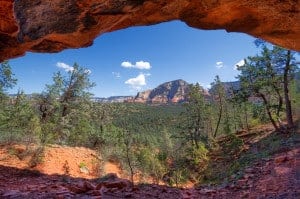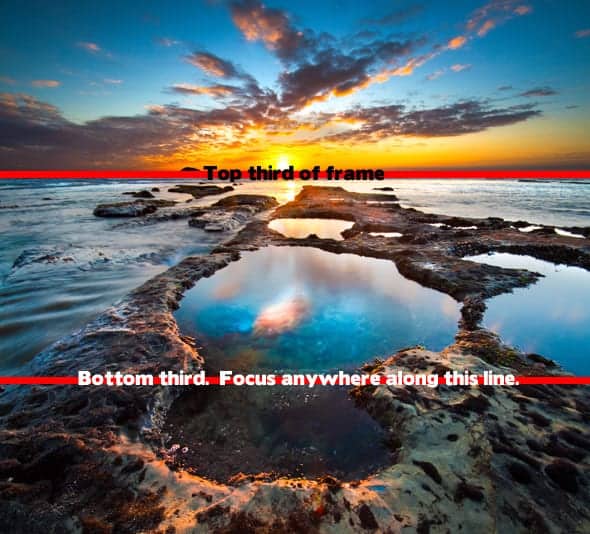
Today's topic comes from Jennifer Brinkman, who submitted a question on our Facebook Fan Page. Here's her question:
“I've been following your blogs and really appreciate all the great information they contain. I just bought a Tokina 11-16mm lens. This is my first truly wide-angle lens. I'm wondering if there is any trick to getting a really sharp photo with a wide angle lens, other than just using a tripod. When taking a landscape photo, do you focus on the bottom third of the photo as with a regular lens to get most of the landscape in focus?”
If you are interested in learning even more about landscape photography, check out Nick's Advanced Techniques for Landscapes!
The Answer: Hyperfocal Distance
Wide-angle lenses behave much differently than standard lenses. If you didn't catch the post from a few weeks ago, go check out the article on some lesser-known aspects of wide-angle lenses. In that article, I point out that wide-angle lenses have a greater depth-of-field than standard lenses when everything else is equal. If that's a new concept to you, you might want to check out this article on depth-of-field, too.
Although wide-angle lenses will provide greater depth-0f-field for broad landscape photos than standard zoom lenses because of the short focal length, depth-of-field is always a concern when shooting sweeping landscapes.
To achieve maximum depth of field, you'll need to understand hyperfocal distance. Hyperfocal distance is a point where, if the lens is focused at that distance, everything from half that distance all the way to infinity will be in focus. This maximizes the depth of field that can be achieved with any lens.
You can probably tell from the scientific sounding name that hyperfocal distance includes some complicated math that requires the photographer to have an understanding of the circle of confusion. Fortunately, there are two really simple ways to calculate the hyperfocal distance, which will, in turn, tell you where to focus the camera.
The first method is to download an app for your smartphone that will tell you exactly how many feet away to focus with the camera gear you are using. I recommend DoF Master if you're using Android or an iPhone.
Quite frankly, I rarely run into a situation where I feel it necessary to go the scientific route. Generally, the hyperfocal distance will be one-third the way up from the bottom of the scene. So in the picture featured below, you would focus one-third up from the bottom of the frame, which would be If you focus there, you'll maximize your depth-of-field and get everything from near to far in focus. So where should you focus your wide-angle lens for landscape photography? Usually, one-third up from the bottom of the frame.

I should caution you, however. If you follow my advice on landscape composition and include foreground elements, you may want to focus much closer than one-third the way into the scene because you'll want the foreground object to be in extremely sharp focus, and that's more important than losing a tiny bit of sharpness of the objects far in the background.
Also, even more important than using the proper hyperfocal distance for your scene is using the proper aperture.

Depending on your camera, you can use an equivalent exposure. For example, I shoot with Nikon cameras, and their Program Mode has a feature called Program Shift. The way it works it when you turn on the camera, it gives you what it thinks is a correct exposure. If this is not the exposure you want, you turn the rear dial to choose an equivalent exposure. Turn to the right for less depth of field or turn to the left for more depth of field. Hope this helps.
Would this be the same with a Sony mirrorless camera?
Yes
Thanks for the very informative article. I’ve been wrestling with this very subject, so I’ll be taking your advice to the field for some trial shots. I also think that Rick Dickson mentioned some valid points, so I’ll merge them both – and see what happens.
These are really great photos! Sometimes, the best way to improve is to be inspired by othersSome other landscape photographers I also enjoy are: Max Rive, Mark Gray, and Antony Spencer. Here is a really cool link including those guys, and some more, for those who are eager to be inspired:http://www.adoramapix.com/blog/2016/11/22/top-10-landscape-photographers-to-follow-on-instagram/#.WFYrp6IrIRE
Thanks for very useful information that you shared with us about landscape focusing. but I wonder if we were on a high land where nothing like trees, rocks and etc is in front of us to focus on it how we can take a sharp image. I really appreciate it if you answer my question.
I am a novice so apologise in advance when you say focus at the line in the lower third.
Do you mean focus here with the red dot – press shutter half way & then move the camera into the position where you want to take the picture?
thanks
Hi
Should I use auto or manual focus please?
Jim
A little late posting here, BTW IP podcasts are great, however, I’ve just written a short piece on hyperfocal focusing on my blog at http://photography.grayheron.net
The problem with hyperfocal focusing is the fact that at infinity the image is only just in focus, by definition. Also if you focus at the HF point and under focus, your focus at infinity collapses quickly.
Alternative approaches for landscape photographers are to focus at infinity and stop the lens down to the smallest detail you wish to see in the foreground. That is with a 100mm lens at F/10, it is simply 10, ie 100/10.
The 2/3 into the frame is not a safe approach.
Always focus beyond the HF for safety.
For the Canon IP folk you can use my Landscape Focusing Helper Script, which you can download from my blog, as long as you have Magic Lantern running.
This automatically puts an AF lens at the HF and provides you blur data at infinity, so you can fine tune your focus. You also get the near depth of field that meets the infinity focus blur criteria.
Cheers
Garry
Great Article..!! It’s very helpful this article, also appreciated.
When in doubt where to focus, take two pictures – one at 1/3 from the bottom and one at infinity !